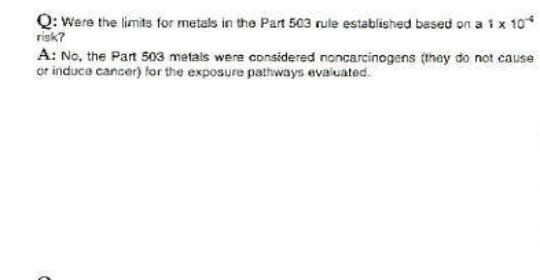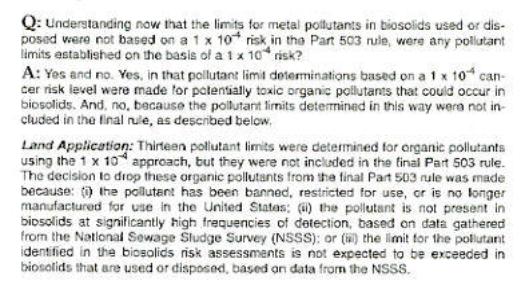| EPA's NON-RISK ASSESSMENT |
| We expect that EPA is required to tell the truth. What we find is that EPA will lie about what it actually does. In 1995, EPA wrote a convincing book on the science behind the part 503 risk assessment. Yet, on page 110, EPA stated it didn't use any science or consider all of the chemicals. EPA's John Walker and USDA's Rufus Chaney appear to be the main source of this non-science. According to EPA,the sludge health risk assessment was only based on looking at 13 organic chemicals which were either already banned, no longer manufactured or restricted for use. These were dropped from consideration in the rule. However, EPA ignored a large list of chemicals known to cause death, cancer and other bodily harm through the air, water and food chain. EPA has admitted (1989) there are at least twenty-one carcinogens (cancer causing agents) in sludge which were removed from the final 503. (FR 54,p. 5777). In spite of its own research, EPA said it did not consider any of the cancer causing hazardous metals in sludge to be cancer causing agents for the risk assessment. See below. EPA has admitted (1989) that five of the admitted twenty-one carcinogens in sludge are carcinogenic when inhaled in dust -- Arsenic, Beryllium, Cadmium, Chromium IV and Nickel. (FR 54, p. 5777) In spite of that, EPA said in 1993, The Agency concluded that Congress intended that EPA develop the part 503 pollutant limits for a broader range of substances that might interfere with the use and disposal of sewage sludge, not just the 126 priority pollutants"? (FR. 58, 32, p. 9327) Yet, EPA listed 25 pathogen which it claimed only caused gastroenteritis, but forgot to included some very deadly bacteria and viruses. http://www.epa.gov/owm/mtb/biosolids/503rule/ A Guide to the Biosolids Risk Assessments for the EPA Part 503 Rule EPA832-B-93-005 Chapter 6 (PDF file, 1143K) Questions and Answers on the Part 503 Risk Assessments http://www.epa.gov/owm/mtb/biosolids/503rule/503g_ch6.pdfE |

The first page (109) of Chapter 6 is the biggest misrepresentation of the facts. It
appears to assure the public that EPA assessed the potential risk to humans,
animals and plants from the pollutants in sludge. The next page states the lie. EPA
only looked at selected pollutants (13 organics).
appears to assure the public that EPA assessed the potential risk to humans,
animals and plants from the pollutants in sludge. The next page states the lie. EPA
only looked at selected pollutants (13 organics).

On the second page (110) of Chapter 6, EPA admits that it did not evaluate any
of the hazardous metals in sludge because it considered them to be non-cancer
causing agents for the 14 pathways evaluated.
Not only that, but EPA admitted it did not evaluate any organic chemical that was
not either already banned, no longer manufactured or had restricted use.
of the hazardous metals in sludge because it considered them to be non-cancer
causing agents for the 14 pathways evaluated.
Not only that, but EPA admitted it did not evaluate any organic chemical that was
not either already banned, no longer manufactured or had restricted use.

On page 56 of chapter 3, EPA claims that the USDA recommended removing the
3,000 ppm of chromium from the regulation because there was no evidence of
damage to plants or animals.
3,000 ppm of chromium from the regulation because there was no evidence of
damage to plants or animals.

The biggest lie was that EPA claimed the court stated that chromium should be
dropped from the regulation. What the court said (in simple terms) was that
Chromium 4 could be as bad as Chromium 6 in crops. EPA told the court that it
only had a few pot studies for chromium and it had no confidence in them.
(Leather Industries of America, Inc. v. EPA. Nos. 93-1187, 93-1376, 93-1404, and
93-1555 - 40 Federal Reporter, 3d Series p. 392
dropped from the regulation. What the court said (in simple terms) was that
Chromium 4 could be as bad as Chromium 6 in crops. EPA told the court that it
only had a few pot studies for chromium and it had no confidence in them.
(Leather Industries of America, Inc. v. EPA. Nos. 93-1187, 93-1376, 93-1404, and
93-1555 - 40 Federal Reporter, 3d Series p. 392

EPA said the Court stated the 3,000 ppm Chromium should be dropped from the
regulation. While the court didn't say that, EPA dropped chromium from the land
application section of the regulation. However, EPA did not remove the 600 ppm limit
on Chromium from the Surface Disposal section of part 503. You still couldn't put
EPA's exceptional quality biosolids in a permitted surface disposal site with unlimited
Chromium. But it can be put on food crops as well as lawns and gardens.
regulation. While the court didn't say that, EPA dropped chromium from the land
application section of the regulation. However, EPA did not remove the 600 ppm limit
on Chromium from the Surface Disposal section of part 503. You still couldn't put
EPA's exceptional quality biosolids in a permitted surface disposal site with unlimited
Chromium. But it can be put on food crops as well as lawns and gardens.
On page 116 of the 503 Risk assessment, EPA claimed that sludge was safe based
on operational standards and crop restrictions.
on operational standards and crop restrictions.

The implication is that EPA actually included the crop harvesting and site restriction
standards in the part 503 and it did leave them in the policy regulation. The reality is
that EPA included all food crops in the final 30 day animal feed crop and fiber crop
restriction. This was a major change from the 1989 proposed sludge regulation.
If the original site restrictions (still in part 503 had been retained), 14 months for above
ground crops, 20 months and 38 months for below ground crops, no farmer would have
considered using sludge.
standards in the part 503 and it did leave them in the policy regulation. The reality is
that EPA included all food crops in the final 30 day animal feed crop and fiber crop
restriction. This was a major change from the 1989 proposed sludge regulation.
If the original site restrictions (still in part 503 had been retained), 14 months for above
ground crops, 20 months and 38 months for below ground crops, no farmer would have
considered using sludge.
§ 503.9 General definitions
(l) Food crops are crops consumed by humans. These include, but are not limited to,
fruits, vegetables, and tobacco.
(j) Feed crops are crops produced primarily for consumption by animals
(k) Fiber crops are crops such as flax and cotton.
§ 503.32 Pathogens.
(b)(5) Site restrictions.
When EPA decide to hell with public health, it added food crops to the 30 day feed and
fiber crop restriction.
(iv) Food crops, feed crops, and fiber crops shall not be harvested for 30 days after
application of sewage sludge.
§ 260.10 Definitions
Food-chain crops means tobacco, crops grown for human consumption, and crops
grown for feed for animals whose products are consumed by humans.

P.109